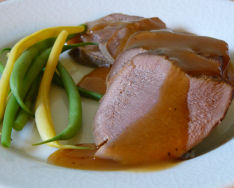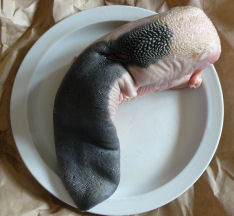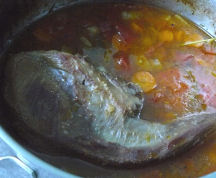 When my mother married my father, she was in her early 20s and he was a high-level military officer who soon ascended to being a military governor. Mom tells me how intimidating it was to have to host official dinner parties practically every night. She had two cooks under her command, one who prepared French food and the other was a master of Vietnamese and Chinese preparations. She learned from her staff, and took private lessons too, so that she would know how the flavors of all three cuisines came together and could oversee their work and plan menus.
When my mother married my father, she was in her early 20s and he was a high-level military officer who soon ascended to being a military governor. Mom tells me how intimidating it was to have to host official dinner parties practically every night. She had two cooks under her command, one who prepared French food and the other was a master of Vietnamese and Chinese preparations. She learned from her staff, and took private lessons too, so that she would know how the flavors of all three cuisines came together and could oversee their work and plan menus.
After we arrived in the U.S. in 1975, Mom no longer had a kitchen staff, except for her four daughters, but she had no problem whipping up Vietnamese, Chinese, and French classics herself. That's why and how I grew up enjoying braised beef tongue. It was a part of the extensive Vietnamese repertoire, which is an amalgam of Southeast Asian, East Asian, South Asian and French influences. With the Vietnamese diaspora, let's just say the cuisine of Vietnam spans East and West.
My mother made this tongue dish every once in a while, and I relished its savory rich flavors and velvety soft, fine texture. After not having had it for years, I requested it and my mom revealed that beef tongue was pricey and it was a splurge to feed our voracious family of seven. Duh, a cow has only one tongue, which made this dish even more precious to me!
In honor of Bastille Day (yesterday), I decided to prepare beef tongue myself. This preparation is based on one for luoi bo (langue braisee) from a 1940s Vietnamese cookbook written by Mrs. Van Dai, Lam Bep Gioi. A fabulous teacher and straightforward writer, she had an entire section of her classic book devoted to French preparations. I compared her recipe to those in the popular French home cookbook, La Bonne Cuisine de Madame E. Saint-Ange, which was published by Larrouse in the late 1920s and recently translated into English by Paul Aratow. The recipes are practically the same. Given the time span between publications, Mrs. Van Dai may have gotten her hands on Saint-Ange's book. Plus, beef tongues don't change that much over time and long cooking is required to sufficiently soften the muscle fibers.
I've seen few Vietnamese preparations of beef tongue. (It's not a widely popular dish since there's only so much tongue to go around.) The one recipe I came across is similar to this one here, though the instructions were for slicing the raw tongue up, marinating it in onion, fish sauce, and pepper, simmering it with chopped fresh tomato and then thickening the cooking liquid with flour mixed with water; the tough outer skin of the tongue isn't removed. That recipe is quite akin to Mrs. Van Dai's slightly more refined French approach. And I suppose that if she didn't have parsley or thyme, she may have substituted a handful of cilantro, or omitted the herbs altogether. She knew about parsley and called it western cilantro in her writing. Bay leaf would have been available since many Viet cooks included it in curries.
 Serve this old-fashioned, homey French preparation with mashed potatoes or buttered noodles and a blanched seasonal vegetable like green beans, peas or broccoli. In late fall-early winter, chestnuts would be fabulous.
Serve this old-fashioned, homey French preparation with mashed potatoes or buttered noodles and a blanched seasonal vegetable like green beans, peas or broccoli. In late fall-early winter, chestnuts would be fabulous.
The tongue I used is from last year's grass-fed beef supply, which I had to use up in the freezer to make room for this year's order from rancher Joe Morris. Tongues from regular markets often lack the black marking. Don't be squeamish about cooking tongue. It's marvelous, and if you're going to eat beef, practice a head-to-tail rigor to pay full respect to the animal.
Serves 6
1 (3 to 4 pound) beef tongue
2 tablespoons rendered pork fat or oil
1 large yellow onion, cut into ¼-inch thick slices
2 carrots, cut into coins
¼ cup dry white wine or vermouth
2 bay leaves
4 to 6 sprigs fresh parsley
4 to 6 sprigs fresh thyme
3 ripe Roma tomatoes, cored and coarsely chopped
1 teaspoon salt
4 ¼ cups water
1 tablespoon cornstarch dissolved in 1 ½ tablespoons water
1. Rinse the tongue and put it into a large, deep pot, like a 6-quart Dutch oven. Add enough water to cover by 2 inches. Bring to a boil over medium high heat and reduce the heat to simmer vigorously. Cook for 20 minutes. Remove from the heat, put the tongue in a bowl of cold water and allow to cool.
2. When cool enough to handle, drain, discarding the liquid. Remove the tough outer white skin and any black parts from the tongue. Use a sharp knife with a thin blade, and start from the pointy tip to cut away the skin. I usually remove the top layer and then attack the underside. You won’t be able to get at all of it on the first pass and will have to scrape and/or cut off residual bits. Rinse to remove any clinging bits and pat dry.
3. Position a rack in the middle level of the oven and preheat to 375F. In an oven-safe pot, heat the fat over medium-high heat. Add the onions and then snuggle the tongue between the onions. Reduce the heat a tad and brown the tongue lightly, about 4 minutes total. The onions will turn color a bit by the time you’re done.
4. Add the carrots and give things a stir. Splash in half of the white wine, and put the lid on. Cook for 6 to 8 minutes, shaking the pot about every 2 minutes to prevent the onions and carrots from burning.
5. Add the remaining white wine, bay leaf, parsley, thyme, tomato, and salt. Cover and cook for about 5 minutes, stirring occasionally, until the tomato has softened and is nearly collapsed.
6. Add the water and bring to a boil. Cover the pot, and then slide it into the oven. Bake (the liquid should simmer) for 45 minutes per pound, or until a toothpick easily pierces the tongue. Every 30 minutes, turn the tongue for even cooking.
 7. Remove from the pot from the oven. Transfer the tender tongue (which resembles an old shoe) to a plate and cover to keep warm and prevent drying. Strain the cooking liquid and degrease it. You should have about 2 ½ cups. (If preparing in advance, allow the tongue to cool in the pot and refrigerate. Degrease by lifting off the fat that will congeal on top. Reheat the tongue and cooking liquid over medium heat before proceeding to remove the tongue and straining the liquid.)
7. Remove from the pot from the oven. Transfer the tender tongue (which resembles an old shoe) to a plate and cover to keep warm and prevent drying. Strain the cooking liquid and degrease it. You should have about 2 ½ cups. (If preparing in advance, allow the tongue to cool in the pot and refrigerate. Degrease by lifting off the fat that will congeal on top. Reheat the tongue and cooking liquid over medium heat before proceeding to remove the tongue and straining the liquid.)
8. Bring the liquid to a boil and let it reduce to 1 ¾ to 2 cups. Taste and add salt or pepper, if needed. Give the cornstarch a stir, and add to the sauce. Cook for about 30 seconds longer, or until the sauce is silky and slightly thickened. Turn off the heat and cover to keep warm. (If the tongue is cold by this point, put it into the sauce to gently reheat it before slicing.)
9. To serve, halve the tongue lengthwise and then cut into slices or cut the whole tongue into slices. (You can do a bit of both too since the more end is a lot bigger than the tip.) Regardless, cut at a slight angle in the narrower parts to craft more evenly-sized pieces. Arrange on a plate. Pour some of the sauce on top to moisten the tongue and serve the rest on the side.
You can also put the sliced tongue in the sauce to warm and lightly coat and then arrange on a plate to serve.

















anh says
How interesting! I don't recall eating a lot of Beef Tongue, but this is certainly something I would love to try.
Andrea Nguyen says
Well, beef tongue was a luxury in Vietnam since beef was, and still is, pricey relative to pork and seafood. That's probably why you hadn't eaten lots of it. The US is a beefy place, so my mother often came across tongue at the local supermarket and when her pocketbook was a bit full, she'd make it for our family. She's nearly 73 and when I mentioned it to her on Saturday, she wistfully responded, "Hmmm, that'll be good." My husband's 86-year-old aunt (who's not Viet) had a similar reaction. Bee
Rosa says
This dish looks wonderful! I love tongue, but have never prepared it myself...
Rosa says
This dish looks wonderful! I love tongue, but have never prepared it myself...
Andrea Nguyen says
This was my first personal foray into cooking tongue. I'd cooked pork tongue before for Vietnamese headcheese (gio thu) but beef tongue is gigantic by comparison. It was somewhat intimidating at first to handle the raw tongue. It's a bit bristly feeling on top. But then, I said to myself, "Get over it" and plunged ahead. It's exceptionally beefy smelling when cooking, and unusually rich tasting, though there's no fat in the tongue itself.
s. lenz says
When boiling the beef tongue for ease of skin removal, by adding a couple of star anise, a smashed good chunk of ginger, the gamey-ness is eliminated. I also add a couple cubes of beef bouillon cubes to keep the flavor of the tongue from being boiled out. I also find that after the tongue has come to simmer for half an hour, letting it sit in the stock with the fire off, lid on for another half hour makes the peeling quite a breeze. The skin often slips right off with a several good tugs.
A
Andrea Nguyen says
Thanks for the skin removal tip! Indeed, Mexican cooks favor tongue for tacos de lengua. Yum.
Kym says
I always order beef tongue at the Thai restaurant I go to -- the chilli helps to mask the flavour.
But that photo...really turns me off.
invierta proyectos says
Very informative post! Keep the nice job. We would love to see more. Great dish!
coach outlet says
Well, beef tongue was a luxury in Vietnam since beef was, and still is, pricey relative to pork and seafood. That's probably why you hadn't eaten lots of it. The US is a beefy place, so my mother often came across tongue at the local supermarket and when her pocketbook was a bit full, she'd make it for our family.
Car Ornaments says
Wisdom appears in contradiction to itself, which is a trick life plays on philosophy of life.
Yukon Hay Farmer says
I was just given a beef tongue this afternoon from an organic farmer who also happens to be the best neighbour in the world. Your recipe is very different than the way my mother, who was of German decent prepared it. I think I will give your recipe a go as it sounds to be very tasty. I do agree that the picture however is not that appetizing to look at.
AJ says
I am Filipino by heritage, but our whole family resides in the US, Hawaii to be precise. We come from a family of farmers and we owned quite a bit of farm animals, mainly cows. Whenever our family slaughtered a cow, our neighbors, family and friends would come over our house and help with the process. Everything on the cow that is edible and safe to eat is saved and eaten. One of the most priced part of the cow is the tongue and the sack that contains the bile. The sack is also cleaned and eaten
carpinteyronne says
Vente Doudoune Moncler 2011! moncler, Moncler Acheter vestes en duvet, des femmes Moncler Vestes, doudoune moncler pas cher,La société d'investissement Eurazeo prend 45 % du célèbre fabricant de doudounes sally forth 418 millions d'euros.
pletcherojs says
Vente Doudoune Moncler 2011! moncler, Moncler Acheter vestes en duvet, des femmes Moncler Vestes, moncler femme,La société d'investissement Eurazeo prend 45 % du célèbre fabricant de doudounes certainly 418 millions d'euros.
Elsie says
Very interesting! Thanks for the post - I just got some pork tongue in my fridge and wanted to find some new options! 🙂
carpinteyrowyl says
Vente Doudoune Moncler 2011! [url=http://www.doudoune-monclerpascherfr.com]doudoune moncler[/url], Moncler Acheter vestes en duvet, des femmes Moncler Vestes, [url=http://www.doudoune-monclerpascherfr.com]moncler femme[/url],La société d'investissement Eurazeo prend 45 % du célèbre fabricant de doudounes dream up of 418 millions d'euros.
pletcherdwf says
Vente Doudoune Moncler 2011! [url=http://www.doudoune-monclerpascherfr.com]doudoune moncler[/url], Moncler Acheter vestes en duvet, des femmes Moncler Vestes, [url=http://www.doudoune-monclerpascherfr.com]moncler femme[/url],La société d'investissement Eurazeo prend 45 % du célèbre fabricant de doudounes certainly 418 millions d'euros.
Canada Goose says
today we have higher buildings and wider highways,but shorter temperaments and narrower points of view;
Agoniirrido says
yWihOnhNf philadelphia eagles jerseys fCpiLfnDb http://social-garden.com/blogs/entry/new-york-rangers-jersey-78ba
zeglekslile says
ONXNZXMKEV winnipeg jets jersey JEGKHCGQNK http://vidood.com/dolph/blogs/entry/anaheim-ducks-jersey-23yq
Melissa says
I tried this recipe tonight and my husband and I were both impressed. Even my 3-year-old ate it!!! Of course, we couldn't bring ourselves to tell him what it was. Taking the outter skin from the tongue was more difficult than I anticipated but I think it just takes practice. Also, I didn't feel I needed to add a thickener to the sauce, which was quite good. I reduced the liquid and used an emersion/stick blender for the veggies and it was thick enough for our liking.
Mr. Cooking Grill says
Great Recipe! it really is and must be appreciated by all! 🙂
marlon says
Very interesting! Thanks for the post. Keep the nice job. We would love to see more. Great dish!
Hdjbfdh says
Chungo chungo rungo and a bungo